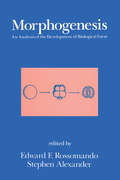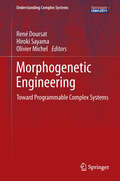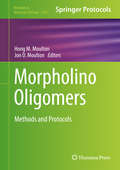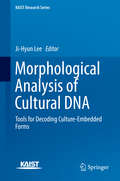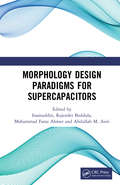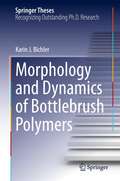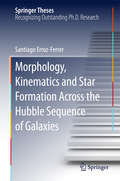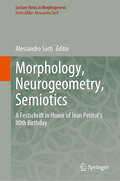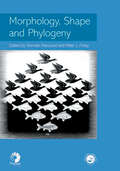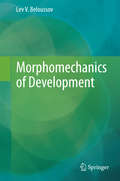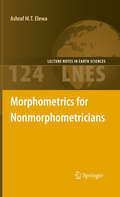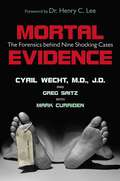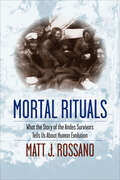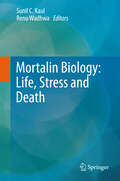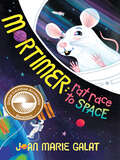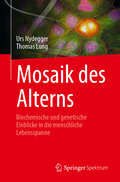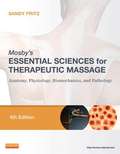- Table View
- List View
Morphogenesis: An Analysis of the Development of Biological Form: An Analysis of the Development of Biological Form
by Stephen Alexander Edward F. RossomandoAn integrated reference which could form the basis for advanced courses on development or become a resource for individuals teaching basic courses. Following an introduction by the volume editors, the 11 chapters represent 11 different systems, arranged phylogenetically. This in-depth volume explores all the major morphogenic systems from bacteria to vertebrates. Presenting a comprehensive picture of the events and mechanisms that contribute to the development of the mature biological form. Written by internationally recognised authorities in the field ‘Morphogenesis’ provides novel insights into the function of multicellularity and morphogens in morphogenesis… details prokaryotic and eukaryotic systems as well as the more complex morphogenesis of mammals and birds…analyses the similarities and differences between the morphogenic strategies used by diverse organisms and identifies the unique advantages of each…describes basic concepts of each biological system, current research developments, and future directions in research…considers the impact on each system of gene function, the environment., pattern formation, and the intercellular communication and information transfer…examines that biochemical, molecular biological, and genetic approaches used to study each system and more. Generously referenced with more than 1525 bibliographic citations, ‘Morphogenesis’ is essential reading for molecular., cell, and developmental biologists; biochemists; microbiologists, and upper level undergraduate and graduate students in these disciplines.
Morphogenetic Engineering
by René Doursat Hiroki Sayama Olivier MichelGenerally, spontaneous pattern formation phenomena are random and repetitive, whereas elaborate devices are the deterministic product of human design. Yet, biological organisms and collective insect constructions are exceptional examples of complex systems that are both self-organized and architectural. This book is the first initiative of its kind toward establishing a new field of research, Morphogenetic Engineering, to explore the modeling and implementation of "self-architecturing" systems. Particular emphasis is placed on the programmability and computational abilities of self-organization, properties that are often underappreciated in complex systems science--while, conversely, the benefits of self-organization are often underappreciated in engineering methodologies. Altogether, the aim of this work is to provide a framework for and examples of a larger class of "self-architecturing" systems, while addressing fundamental questions such as > How do biological organisms carry out morphogenetic tasks so reliably? > Can we extrapolate their self-formation capabilities to engineered systems? > Can physical systems be endowed with information (or informational systems be embedded in physics) so as to create autonomous morphologies and functions? > What are the core principles and best practices for the design and engineering of such morphogenetic systems? The intended audience consists of researchers and graduate students who are working on, starting to work on, or interested in programmable self-organizing systems in a wide range of scientific fields, including computer science, robotics, bioengineering, control engineering, physics, theoretical biology, mathematics, and many others.
Morpholino Oligomers
by Hong M. Moulton Jon D. MoultonThis volume presents a historical perspective on Morpholinos, an overview of good Morpholino practices, techniques for controlling Morpholino activity with light, techniques for modulating microRNA activity in zebrafish embryos, probing genes during fin regeneration, methods for determining to structure of gene networks during development, electroporation, bacterial knockdowns, pretargeting, diagnostic applications of Morpholinos, techniques for delivering Morpholinos in utero to developing embryos, and methods offering rapid, hands-free, label-free and inexpensive assays of Morpholino concentrations in biological extracts. Written in the highly successful Methods in Molecular Biology series format, chapters include introductions to their respective topics, lists of the necessary materials and reagents, step-by-step, readily reproducible laboratory protocols, and tips on troubleshooting and avoiding known pitfalls. Morpholino Oligomers: Methods and Protocols aims to provide a diverse application of Morpholinos along with protocols that will assist new labs in moving the frontier.
Morphological Analysis of Cultural DNA
by Ji-Hyun LeeThis volume describes research in computational design which implements shape grammars or space syntax for morphological analysis, applying these scientific and rule-based methodologies to cultural aspects of the field. The term 'cultural DNA' describes the effort to explore computational design from the perspectives of a meme, a socio-cultural analogy to genes. Based on the 1st Cultural DNA Workshop, held at KAIST, Daejeon, Korea in 2015, the book considers whether there is such a thing as a 'cultural DNA' common throughout various domains, and if so how computer-assisted tools and methodologies play a role in its investigation. Following an introduction covering some fundamental theories of cultural DNA research, part two of the book describes morphological analysis in architecture, with examples from Malaysia and China. Part three then moves up to morphological analysis at the urban scale, including discussion of morphological evolution in France, development of a model Korean city, and introducing a rule-based generative analysis approach for urban planning. Part four considers methods for analysing the DNA of other cultural artefacts such as online games, novels, cars, and music, and part five introduces the tools under development that aid morphological cultural DNA research including topics about shape grammar, building information modeling (BIM), cultural persona, and prototyping. The book will be of significant interest to those involved in the cultural aspects of urban and architectural design, cultural informatics and design research.
Morphology Design Paradigms for Supercapacitors
by Inamuddin Abdullah Mohamed Asiri Rajender Boddula Mohammad Faraz AhmerNanostructured electrode materials have exhibited unrivaled electrochemical properties in creating elite supercapacitors. Morphology Design Paradigm for Supercapacitors presents the latest advances in the improvement of supercapacitors, a result of the incorporation of nanomaterials into the design – from zero-dimensional to three-dimensional, and microporous to mesoporous. The book includes a comprehensive description of capacitive practices at the levels of sub-atomic and nanoscales. These have the ability to enhance device performance for an extensive assortment of potential applications, including consumer electronics, wearable gadgets, hybrid electric vehicles, stationary and industrial frameworks. Key Features: Provides readers with a clear understanding of the implementation of these materials as electrodes in electrochemical supercapacitors. Covers recent material designs and an extensive scope of electrode materials such as 0D to 3D. Explores recent nanostructured-system material designs that have been created and tested in supercapacitor configurations. Considers microporous to mesoporous supercapacitor electrode materials. Features the impact of nanostructures on the properties of supercapacitors, including specific capacitance, cycle stability, and rate capability.
Morphology and Dynamics of Bottlebrush Polymers (Springer Theses)
by Karin J. BichlerThis thesis makes significant advances to the understanding of bottlebrush polymers. While bottlebrushes have received much attention due to the recent discovery of their unprecedented properties, including supersoftness, ultra-low viscosity, and hyperelasticity, this thesis is the first fundamental investigation at the molecular level that comprises structure and dynamics. Neutron scattering experiments, detailed within, reveal spherical or cylindrical shapes, instead of a random coil conformation. Another highlight is the analysis of the fast dynamics at the sub nm-length scale. The combination of three neutron spectrometers and the development of a new analysis technique enabled the calculation of the mean-square displacement over seven orders of magnitude in time scale. This unprecedented result can be applied to a broad class of samples, including polymers and other materials. The thesis is accessible to scientists from other fields, provides the reader with easily understandable guidelines for applying this analysis to other materials, and has the potential to make a significant impact on the analysis of neutron scattering data.
Morphology and Evolution of Turtles
by Donald B. Brinkman James D. Gardner Patricia A. HolroydThis volume celebrates the contributions of Dr. Eugene Gaffney to the study of turtles, through a diverse and complementary collection of papers that showcases the latest research on one of the most intriguing groups of reptiles. A mix of focused and review papers deals with numerous aspects of the evolutionary history of turtles, including embryonic development, origins, early diversification, phylogenetic relationships, and biogeography. Moreover it includes reports on important but poorly understood fossil turtle assemblages, provides historical perspectives on turtle research, and documents disease and variation in turtles. With its broad scope, which includes descriptions of material and new taxa from Australia, Asia, and Europe, as well as North and South America, this work will be an essential resource for anyone interested in the morphology and evolution of turtles. "This volume's breadth of time, geography, and taxonomic coverage makes it a major contribution to the field and a 'must have' for all vertebrate paleontologists.", James F. Parham, California State University, CA, USA "A comprehensive and sweeping overview of turtle evolution by the top experts in the field that will interest everyone curious about these unique reptiles." Jason S. Anderson, University of Calgary, Canada "An invaluable addition to the literature that covers the full spectrum of approaches toward understanding the evolution of these noble creatures." Ann C. Burke, Wesleyan University, CT , USA "A truly comprehensive volume that both the student of fossil turtles, as well as the general reader interested in these enigmatic creatures, will find fascinating." Tyler Lyson, Yale University, CT, USA
Morphology, Kinematics and Star Formation Across the Hubble Sequence of Galaxies
by Santiago Erroz-FerrerThis thesis discusses the evolution of galaxies through the study of the morphology, kinematics, and star formation properties of a sample of nearby galaxies. The main body of the thesis describes the kinematic observations with the GHaFAS Fabry-Perot instrument on the William Herschel Telescope of a sample of 29 spiral galaxies. The work is closely related to the Spitzer Survey of Stellar Structure in Galaxies, and uses the mid-infrared data of that survey to determine key parameters of the galaxies studied. From these data, important results are obtained on streaming and other non-circular motions in galaxies, on the distribution and rates of star formation, and on how correlations of these parameters and of the rotation curve shape with basic galaxy parameters yield clues on the evolutionary processes taking place in disk galaxies.
Morphology, Neurogeometry, Semiotics: A Festschrift in Honor of Jean Petitot 's 80th Birthday (Lecture Notes in Morphogenesis)
by Alessandro SartiJean Petitot is a polyhedric thinker whose contributions has been fundamental in a number of disciplines, such as epistemology, morphodynamics, differential geometry, structural semiotics, neurogeometry, phenomenology, linguistics, cognitive grammars, the theory of catastrophes, social sciences, literary studies, and aesthetics. This book is a homage to his huge contribution about the main concepts of morphogenesis and meaning that constitute the center of gravity around which Petitotian reflection revolves and returns.The scientific path of Jean Petitot develops between these two poles, topology and meaning. At stake it was to challenge the hiatus separating the exact sciences from the humanities that was the main point of the Petitot seminar of EHESS Epistemology of Models. By designing the appropriate qualitative dynamics between the two poles, form and meaning, it is possible to understand the Saussurian sign in structural semiotics, or the Greimasian semiotic square fordeep narrative structures or even the canonical formula of the myth of Lévi Strauss in structural anthropology. These are just few results in applying the theory of catastrophes to the emergence of meaning. The book is a collection of testimonies by distinguished authors who worked extensively with Jean Petitot in the different fields of Mathematics, Neurogeometry, Semiotics, Aesthetics, and Epistemology. An extensive bibliography of Petitot’s work is also presented.
Morphology, Phylogeny and Taxonomy of Osteolepiform Fish (Fossils and Strata Monograph Series #61)
by Ulf J. BorgenA discussion and description of prehistoric fish within an international series Material of six osteolepiform genera is described in Morphology, Phylogeny and Taxonomy of Osteolepiform Fish. This publication is Number 61 within the Fossils and Strata series. The international Fossils and Strata series features monographs in palaeontology and biostratigraphy with taxonomic descriptions. The series is owned by and published on behalf of The Lethaia Foundation in cooperation with the Scandinavian countries.
Morphology, Shape and Phylogeny (Systematics Association Special Volumes)
by Norman MacLeod Peter L. ForeyGenerally, biologists and mathematicians who study the shape and form of organisms have largely been working in isolation from those who work on evolutionary relationships through the analysis of common characteristics. Increasingly however, dialogue between the two communities is beginning to develop - but other than a handful of journal papers, there has been no formal, published discussion on this subject. This timely book summarises the interdisciplinary work that has taken place and will stimulate additional research into these topics. Any scientist working on evolutionary relationships will find this volume invaluable.
Morphomechanics of Development
by Lev V. BeloussovThis book outlines a unified theory of embryonic development, assuming morphogenesis to be a multi-level process including self-organizing steps while also obeying general laws. It is shown how molecular mechanisms generate mechanical forces, which in the long run lead to morphological changes. Questions such as how stress-mediated feedback acts at the cellular and supra-cellular levels and how executive and regulatory mechanisms are mutually dependent are addressed, while aspects of collective cell behavior and the morphogenesis of plants are also discussed. The morphomechanical approach employed in the book is based on the general principles of self-organization theory.
Morphometrics for Nonmorphometricians
by Ashraf M.T. ElewaMorphometrics is concerned with the study of variations and change in the form (size and shape) of organisms or objects adding a quantitative element to descriptions and thereby facilitating the comparison of different objects and organisms. This volume provides an introduction to morphometrics in a clear and simple way without recourse to complex mathematics and statistics. This introduction is followed by a series of case studies describing the variety of applications of morphometrics from paleontology and evolutionary ecology to archaeological artifacts analysis. This is followed by a presentation of future applications of morphometrics and state of the art software for analyzing and comparing shape.
Mortal Evidence: The Forensics Behind Nine Shocking Cases
by Cyril H. WechtA lifeless newborn baby is found discarded in a motel Dumpster. Authorities quickly arrest the infant's teenage parents, charging them with murder. Did Amy Grossberg and Brian Peterson, in fact, murder their own baby? Tammy Wynette died suddenly at a relatively young age, and yet no autopsy was performed? Was someone trying to hide the real cause of death? Did Sam Sheppard (later dubbed "The Fugitive" based on a television series) really kill his wife? And if not, who committed the murder? Things are not always as they appear, as world-renowned forensic pathologist Dr. Cyril Wecht shows in this riveting behind-the-scenes look at nine famous cases. In the nationally known baby case involving Amy Grossberg and Brian Peterson, Dr. Wecht reviews the evidence and comes to a startling conclusion. In fascinating detail, he demonstrates how the tools of forensic pathology often uncover murky, long-hidden secrets that crack seemingly unsolvable crimes. Writing in the first-person Dr. Wecht leads you into the heart of the investigation, focusing each chapter on a single engrossing drama. He reveals the most startling evidence that shows why JonBenet Ramsey's killer most likely came from within her home, why O.J. Simpson probably had an accomplice in the murder of Nicole Simpson and Ron Goldman, shocking revelations about Robert Berdella's grisly torture and sex-abuse crimes against young men, and many intriguing facts about other infamous cases. If you find the fictional plots of such dramas as C.S.I. exciting, you will be amazed by the true stories told by Dr. Wecht, with the help of two top-flight veteran reporters, Greg Saitz and Mark Curriden, in this amazing real-life thriller. As this intriguing page-turner proves, the science of forensic pathology has changed the face of detective work forever.
Mortal Rituals: What the Story of the Andes Survivors Tells Us About Human Evolution
by Matt J. RossanoA psychology professor examines what the survivors of the airplane crash hailed &“The Miracle of the Andes&” can show us about human evolution.On December 21, 1972, sixteen young survivors of Uruguayan Air Force Flight 571 were rescued after spending ten weeks stranded at the crash site of their plane, high in the remote Andes Mountains. The incident made international headlines and spawned several best-selling books, fueled partly by the fact that the young men had resorted to cannibalism to survive. Matt Rossano examines this story from an evolutionary perspective, weaving together findings and ideas from anthropology, psychology, religion, and cognitive science. During their ordeal, these young men broke &“civilized&” taboos to fend off starvation and abandoned &“civilized&” modes of thinking to maintain social unity and individual sanity. Through the power of ritual, the survivors were able to endure severe emotional and physical hardship. Rossano ties their story to our story, seeing in the mortal rituals of this struggle for survival a reflection of what it means to be human.&“[Rossano&’s] narrative describes a &“microcosm of human evolution,&” and I think this book will grab the interest of many readers―students as well as the general public―as it teaches essential facts about the way Homo sapiens evolved.&”—David Hicks, Stony Brook University and Clare College, Cambridge University &“[Rossano] masterfully weaves a moving contemporary drama with a compelling account of the evolutionary history of ritual and religion. An impressive accomplishment and a truly captivating read from start to finish.&”—Richard Sosis, University of Connecticut, cofounder and coeditor of Religion, Brain, & Behavior
Mortal Rituals: What the Story of the Andes Survivors Tells Us About Human Evolution
by Matt RossanoOn December 21, 1972, sixteen young survivors of Uruguayan Air Force Flight 571 were rescued after spending ten weeks stranded at the crash site of their plane, high in the remote Andes Mountains. The incident made international headlines and spawned several best-selling books, fueled partly by the fact that the young men had resorted to cannibalism to survive. Matt Rossano examines this story from an evolutionary perspective, weaving together findings and ideas from anthropology, psychology, religion, and cognitive science. During their ordeal, these young men broke "civilized" taboos to fend off starvation and abandoned "civilized" modes of thinking to maintain social unity and individual sanity. Through the power of ritual, the survivors were able to endure severe emotional and physical hardship. Rossano ties their story to our story, seeing in the mortal rituals of this struggle for survival a reflection of what it means to be human.
Mortalin Biology: Life, Stress and Death
by Renu Wadhwa Sunil C. KaulThe phrase "Life, stress and death" connects three terms, but is there a biological basis for that? Are there molecules that are essential to/or mediate these phenomena? This contributory volume "Mortalin Biology: Life, Stress and Death" is a remarkable compilation of the research outcomes on the stress protein mortalin, a member of heat shock 70 family of proteins. The book is unique as it describes mortalin playing essential role in life, stress response and death either from cancer, when it becomes hyperactive or from neuro-degeneration, when it becomes hypoactive. The book provides up-to-date knowledge on mortalin with respect to its discovery, structure, evolutionary conservation, function and signal transduction in different organisms in a simple, but most comprehensive way, that besides offering an enjoyable and in-depth reading, prompts the reader to ask further questions to explore this protein with new ideas, approaches and experiments. Twenty-one chapters by the world leaders on the specific areas of mortalin research throw light on its multi-functionality, potentials for biotechnology, diagnostics and therapeutic values. Avenues of mortalin biology, yet unexplored, hold immense promises for future, and reading this volume provides an easy, enthusiastic and energetic head-on start.
Mortimer: Rat Race to Space
by Joan Marie GalatA spot on the International Space Station (ISS) has opened up, and Mortimer, is not about to miss his chance to become an intergalactic space rat. And that’s just the first step in his master plan to prove that rats are much better suited than humans for a future mission to Mars. He packs his camera and prepares to take to the internet with his evidence of rat superiority. But when Mortimer’s schemes go awry, he is forced to face new truths about dreams, friendship, and choosing the right thing to do. Maybe not everything is a rat race.
Mosaic of a Scientific Life
by István HargittaiIn this book, István Hargittai, an internationally renowned physical chemist, narrates his life by introducing over forty personalities that played noteworthy roles in his career. The time span ranges from the Holocaust, which the author survived, through the periods of hard and softer dictatorships of Soviet-type socialism, and the current revival of an autocratic regime in Hungary. He overcame barriers to get a high school, then a university education. He received excellent training in Moscow and was active at Hungarian, American and other international scientific venues, and he has interacted with more Nobel laureates than anyone in the world.The chapters feature such famous contributors to world science as Francis Crick, Richard L. Garwin, Ronald J. Gillespie, Avram Hershko, George Klein, Paul Lauterbur and Peter Mansfield, Peter D. Lax, Paul Nurse, Yuval Ne’eman, George A. Olah, Guy Ourisson, Michael Polanyi, Andrei D. Sakharov, Albert Szent-Györgyi, Edward Teller, James D. Watson, and Eugene P. Wigner. The areas covered include chemistry, molecular biology, physics, materials science, and mathematics.“On the basis of Hargittai’s mosaic of his personal and scientific life, I could compose two further patterns. One would be the history of the twentieth century and the other the science history of the same time period.” From the Foreword by the late philosopher Agnes Heller, Goethe Medalist, Wallenberg Medalist, and Hannah Arendt Prize laureate
Mosaicism in Human Skin
by Rudolf HappleMosaicism is a powerful biologic concept, originally developed from studying plants and animals. All cutaneous neoplasms, both benign and malignant, reflect mosaicism, which is the necessary basis to explain numerous human skin disorders. For example, various mosaic patterns visualize the embryonic development of human skin and X-linked skin disorders explain why women live longer than men, and so on. This book presents, for the first time, a comprehensive overview on the strikingly manifold patterns and peculiarities of mosaic skin disorders. This reader-friendly structured and straightforward publication will help the dermatologist to understand the underlying molecular mechanisms of skin disorders in order to further improve the treatment outcome.
Mosaik des Alterns: Biochemische und genetische Einblicke in die menschliche Lebensspanne
by Urs Nydegger Thomas LungDieses Buch handelt von der lebenslangen Alterung des Menschen. Bisher sind die grundlegenden biochemischen und genetischen Mechanismen unzureichend bekannt und unterscheiden sich von Mensch zu Mensch. Zunächst untersuchen wir, wie die Zeit abläuft und was „normal&“ bedeutet, mit Auswirkungen auf das Genom und die Funktion von Proteinen. Seneszenz, die biologische Alterung der Zelle, ist nicht nur Biochemie, sondern sie bietet auch der Pharmakologie und der labormedizinischen Diagnostik ein großes Tätigkeitsfeld. Zum Beispiel der Einsatz von Medikamenten, um die Seneszenz zu beeinflussen. Seneszenz, die als Einbahnstraße angesehen wird, <
Mosby's Comprehensive Review for Veterinary Technicians
by Monica M. Tighe Marg BrownMaster critical concepts to succeed on your certification exam! Mosby’s Comprehensive Review for Veterinary Technicians, 5th Edition is the ideal review tool which reflects the most recent changes to the Veterinary Technician National Exam (VTNE). This edition features a user-friendly outline format that helps break down information visually for better comprehension of the material. Coverage reinforces key concepts in basic and clinical sciences, clinical applications, patient management and nutrition, anesthesia and pharmacology, medical and surgical nursing, and critical care, and information on pain management. Wide-ranging coverage includes dogs, cats, large animals, birds, reptiles, and laboratory animals. To ensure the most meaningful review, this new edition features a study mode on the Evolve site that includes 500 review questions and an exam mode with a computer-based testing environment similar to what you will encounter when taking the VTNE.
Mosby's Comprehensive Review of Radiography: The Complete Study Guide and Career Planner 6th Edition
by William J. CallawayA complete review for the Registry exam, Mosby's Comprehensive Review of Radiography: The Complete Study Guide and Career Planner, 6th Edition covers the five major subject areas of the ARRT exam in radiography. It is also an effective study guide for many radiography courses! Written in outline format, each review of a subject is followed by questions related specifically to that area. Two mock ARRT exams are included in the book.
Mosby's Essential Sciences for Therapeutic Massage: Anatomy, Physiology, Biomechanics, and Pathology (Fourth Edition)
by Sandy FritzThe fourth edition of this science essentials text for massage students features new full-color photos and illustrations along with an easy-to-read, conversational style that explains A&P concepts clearly. The book not only helps students learn the information they need to pass certification exams, but it also helps them see how scientific content applies to actual practice. This new edition also features a very enhanced Evolve resource package, along with new material on boosting your knowledge of nutrition and research two subjects of growing interest in the massage therapy profession.
Mosbys Complementary and Alternative Medicine: A Research-Based Approach
by Lynda W. FreemanDesigned in a true "textbook" format, this research-based book provides comprehensive and clinically-relevant coverage of complementary and alternative medicine. It covers the history, philosophy, and mechanisms of complementary medicine and alternative therapies, and includes a thorough review of the clinically controlled trials, indications, and contraindications of each therapy. Each chapter follows a consistent format with helpful features, such as: Why Read This Chapter, Chapter at a Glance, An Expert Speaks, review questions, critical thinking questions, clinical application questions, and more.
